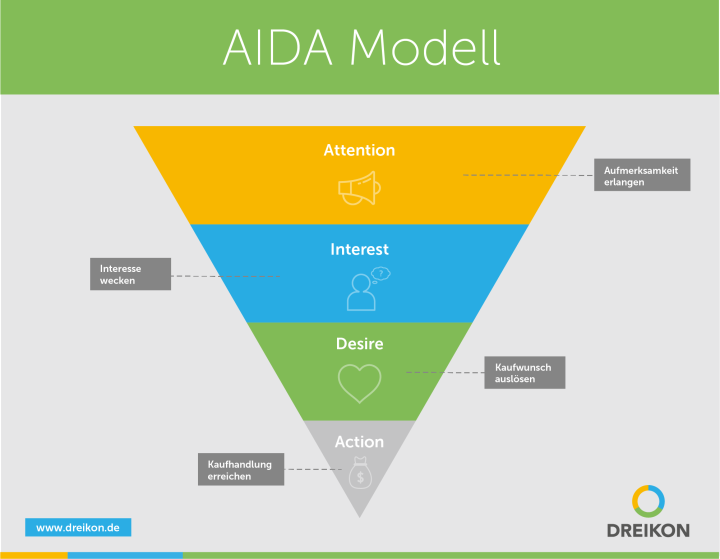AIDA formula
Marketing models are a dime a dozen, but one formula stands the test of time - not only in theory, but also in practice. The AIDA formula has been at the heart of many advertising strategies for two centuries and serves marketing experts as a guideline for formulating suitable advertising messages to attract the attention and interest of consumers, trigger the desire to buy and ultimately guide them successfully to a purchase decision. The principle is therefore the basis for target-oriented sales pitches, advertising measures and advertising copy.
But where does the AIDA formula come from? What does the acronym stand for? What is it used for and who benefits from it? Is it still used in modern marketing? In this glossary entry you will learn everything about the advertising effectiveness principle of the AIDA formula as well as modified principles such as AIDAS and AIDCAS.
The origin of the AIDA formula
The AIDA formula was developed in 1898 by the American marketing strategist Elmo Lewis to provide salespeople with a guide for successful, customer-oriented sales pitches. The first president of the Association of National Advertising divided the sales process into four stages, which a consumer goes through on the way to making a purchase decision and which can be used by salespeople and marketers to formulate appropriate messages.
The AIDA formula - optimizing the sales process
AIDA is an acronym of the English terms Attention, Interest, Desireand Actionand describes the four stages that, according to Lewis, consumers go through before making a final purchase decision. By taking these stages into account when designing advertising measures, messages and sales pitches, companies and salespeople can exert a certain influence on potential customers and consciously steer them towards a purchase decision.

A - Attention
The first stage of the AIDA formula is about attracting the attention of the target group. While this was relatively easy until a few decades ago, this stage now presents companies with a major challenge. Globalization and digitalization have not only significantly increased the range of products and services on offer. At the same time, the volume of advertising messages has increased many times over - particularly due to the development of social media. With the mass of advertising messages that consumers are confronted with on a daily basis, messages can only be perceived selectively. The difficulty for companies is therefore to stand out clearly from the competition. In order to attract the attention of potential customers to themselves and their own offer, advertising must be eye-catching and appealing. The design and content of offline media such as posters, flyers or displays or online websites and landing pages can certainly deviate from the norm in order to stand out. This is possible, for example, with eye-catchers that remain in the memory of potential customers through concise and activating key messages. This is the only way to ultimately trigger a desire to buy and lead the customer to the final purchase action.
I - Interest
Have you successfully captured the attention of potential customers with your advertising message? Now, in the next step, you want to transform your target group into prospective customers and not simply let the attention you have gained fizzle out. This stage of the AIDA formula focuses on communicating relevant product information and addressing potential problems of the target group. In any case, a connection to the advertising message that was used to attract attention must be established. Depending on the offer, special product features or price advantages can be presented at this point, for example, to arouse the interest of the audience. In addition, an appealing design and the textual layout of messages can arouse curiosity and help to attract prospective customers.
D - Desire (desire to buy)
The "Desire" phase of the advertising impact model often goes hand in hand with the "Interest" phase. In order to persuade prospective customers to make the final purchase, you must now trigger the desire to buy in the consumer to really need and want to purchase your product. The focus here is on communicating added value. By presenting aspects such as USPs and advantages for the customer, you offer consumers a solution to your problem, convince interested parties and trigger the desire to buy. Communication on an emotional level is particularly promising. Here, too, an appropriate visual and textual design can achieve a better advertising effect and remain in the memory of future customers in the long term.
A - Action (purchase action)
The last phase in the AIDA formula is reached when the advertising effect occurs and describes the purchase action and, according to Lewis, the conclusion of the sales process. The initial letter A stands for Action. Whether in online or offline retail or in the design of landing pages and advertisements, a sales pitch or an advertising measure finally ends with the purchase action. While in a personal conversation the purchase is the natural result of the previous conversation, companies can use calls to action in the online store or on landing pages, for example in the form of call-to-actions, to persuade potential customers to make a purchase decision. This form of call to action can also be used on offline advertising materials such as flyers, posters and advertisements to make it easier for customers to make a purchase decision.
Criticism of the AIDA advertising impact model
Over the decades, various criticisms have been leveled at the advertising effectiveness model.
Lack of topicality
At over 100 years old, the AIDA formula is often described as outdated, and not without good reason. Not only has the society in which we live, buy and sell been transformed. External influences such as globalization and digitalization have also led to a significant shift in customer and purchasing behavior. The demands on advertising measures have therefore grown considerably and cannot be depicted in Lewis' simplified stage model. In today's advertising psychology, the focus is much more on transforming new customers into returning customers
Static model
The buying behavior of customers is as complex as the human psyche. Critics describe the AIDA formula as a rigid step-by-step model that does not take into account the dynamics of a real purchasing process. In real purchasing decision processes, stages of the AIDA formula may well coincide, have a different sequence and take other areas into account.
Neglect of internal & external factors
The investigation of purchasing behavior is a broad field of study to which countless researchers from various disciplines have devoted themselves. For example, psychological and socio-economic factors as well as macro-economic influences play a role in the purchasing process, which are not taken into account in the AIDA formula. These influences can inhibit the advertising effect and not lead to the desired purchase.
AIDAS & AIDCAS - further development of the AIDA formula
Due to the many points of criticism of the AIDA formula, scientists have spent the last few decades looking in detail at adaptations and extensions to the stage model. Various studies dealing with the modern sales process, the development of advertising strategies and research on the advertising effect have gained new insights and shown that modeling the sales process must take other principles into account. Based on this, the AIDA formula has been further developed by various authors. For example, the AIDAS and AIDCAS models are now more frequently cited and applied in practice than the classic AIDA formula.
AIDAS
The acronym AIDAS covers the four known areas of the AIDA formula and has been supplemented by a further initial letter and aspect: Satisfaction. This advertising impact model does not end with a call to action or the completion of a purchase, but with customer satisfaction. The focus is on satisfying customer needs and can in turn be the starting point for subsequent purchases.
AIDCAS
With the initial letter "C" inserted in between, the AIDCAS stage model stands for Attention, Interest, Desire, Conviction, Actionand Satisfaction. Like the AIDAS principle, this advertising effectiveness principle includes the additional aspect of customer satisfaction and therefore focuses on the satisfaction of customer needs and the prospect of possible follow-up purchases. The principle also proposes the addition of the aspect of persuasion. In this additional stage, the customer is explicitly convinced of your offer and makes the decision to choose your product or service over the competition. In the conventional AIDA formula, the stage of persuasion takes place at the same time as the development of the desire to buy.
Today's application of the AIDA formula
Despite various points of criticism and extensions of the stage model, the basic construct is still recognized and used: potential buyers go through various stages until the final purchase decision is made. Although the AIDA formula was originally developed for the design of successful sales pitches, the stage model, albeit in a modified form as the AIDAS or AIDCAS model, is still used in the age of online retail and the like. The principles can still be applied in stationary sales as well as in online retail in telephone sales conversations or customer advice via chat bot or email. The AIDA formula can also be taken into account in the design of advertising, in content marketing when creating advertising texts etc. and in email marketing, thus guaranteeing a certain advertising effect. In addition to the AIDA formula and variations such as AIDAS and AIDCAS, there are now many more marketing models that deal with customer behavior.
The AIDA formula - Conclusion
The AIDA formula (acronym for Attention, Interest, Desireand Action) has always been known in advertising psychology and is still used today, sometimes modified as the AIDAS or AIDCAS principle, to optimize various communication measures in the advertising context. The aim is to transform people into prospective customers and these in turn into buyers and to generate follow-up purchases by satisfying customer needs. The AIDA formula divides the purchase decision process into four stages. This principle can be used in marketing to optimize advertising strategies by designing advertising materials in such a way that they satisfy the needs of customers separately at each stage. In this way, an optimal advertising effect can be achieved. Similarly, the advertising effectiveness principle can be used for analysis purposes to check the effectiveness of advertising measures.
As various criticisms of the classic AIDA formula have been voiced to date, experts have further developed the advertising effectiveness model and updated it with extensions for modern purchasing and advertising processes as well as communication measures. However, the standard stages remain the same.







